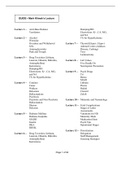Page 1 of 92 Lecture 1— Acid-Base Balance Ventilators Lecture 2— Alcohol Wernicke Overdose and Withdrawal S/Sx Aminoglycosides Peak and Trough Lecture 3— Drug Toxicities (Lithium, Lanoxin, Dilantin, Bilirubin, Aminophylline) Kernicterus Dumping/HH Electrolytes: K+, CA, MG, and NA TX for HyperKalemia Lecture 4— Crutches Canes Walkers Delusions Hallucinations Psychosis Psychotic and Non-Psychotic Hallucination Illusion Delusion Lecture 5— Diabetes Mellitus Diabetes Insipidus SIADH Insulin DKA HHNK Lecture 6— Drug Toxicities (Lithium, Lanoxin, Dilantin, Bilirubin, Aminophylline) Kernicterus Dumping/HH Electrolytes: K+, CA, MG, and NA TX for HyperKalemia Lecture 7— Thyroid (Hyper-, Hypo-) Adrenal Cortex (Addison Disease, Cushing) Toys Laminectomy Lecture 8— Lab Values Five Deadly Ds Neutropenic Precaution Lecture 9— Psych Drugs Tri Benzo MAOI Lithium Prozac Haldol Clozaril Zoloft Lecture 10— Maternity and Neonatology Lecture 11— Fetal Complications Stages of Labor Assessments Variations for NB Maternity Meds Medication Hints Psych Tips Operational Stages Lecture 12— Prioritization Delegation Staff Management Guessing Strategies GUIDE • Mark Klimek’s Lecture Page 2 of 92 Page 3 of 92 Acid/Base Balance (Start times: 30:00) In order to solve acid-base disorders, it is important to know the normal values for pH, CO2 and HCO3 (bicarbonate), which are shown below • pH 7.35 to 7.45 • CO2 35 to 45 • HCO3 22 to 26 The first value to look at in an acid-base disorder is the pH • If pH is <7.35, the acid-base imbalance is acidotic • If pH is <7.45, the acid-base imbalance is alkalotic Now, to determine if the imbalance is metabolic or respiratory, determine whether HCO3 goes in the same or opposite direction with pH • Rule of the Bs: If pH and Bicarb move both in the same direction, then the acid-base imbalance is metabolic … Otherwise, it is respiratory Example #1 • pH 7.3 Acidotic • HCO3 20 Metabolic • This is an example of metabolic acidosis Example #2 • pH 7.58 Alkalotic • HCO3 32 Metabolic • This is an example of metabolic alkalosis Example #3 • pH 7.22 Acidosis • HCO3 35 Respiratory • This is an example of respiratory acidosis As the pH goes, so goes my patient, except for Potassium … That means • If pH is low, everything is low, except potassium • If pH is high, everything is high, except potassium Lecture 1 • Mark Klimek • 92:21 Page 4 of 92 If pH goes over 7.45, this is alkalosis • Therefore everything is up: tachycardia, tachypnea, HTN, seizures, irritability, spastic, diarrhea, borborygmi (increase bowel sounds), hyperreflexia (3+, 4+) • However, potassium is opposite. Therefore, hypokalemia • What is the nursing intervention? o Pt need suctioning because of seizures If pH goes below 7.35, this is acidosis • Therefore, everything is down: bradycardia, constipation, absent bowel sounds, flaccid, obtunded, lethargy, coma hyporeflexia (0, 1+), bradypnea, low BP • However, potassium is high (hyperkalemia) • What is the nursing intervention? o Pt needs to be ventilated with an Ambu bag—respiratory arrest So, remember that “MAC Kussmaul” is the only acid-base imbalance to cause Metabolic ACidosis with Kussmaul respirations Causes of Acid/Base imbalance First ask yourself, “Is it LUNG? … If yes, then it is respiratory • Then ask yourself, “Are they overventilating or underventilating? o If UNDERventilating, then pick acidosis—pH is under 7.35 o If OVERventilating, then it is alkalosis, pH is over 7.45 What type of acid-base derangement is present in the following condition? • In labor? o Respiratory alkalosis … Overventilating—pH increases … Alkalosis) • Drowning? o Respiratory acidosis … Underventilating—pH decreases … Acidosis • Pt is on PCA (patient-controlled anesthesia) pump? o Ventilation is down … Respiratory acidosis If it is not LUNG, then it is metabolic. If the patient has prolonged gastric vomiting or suction (sucking out acid), pick alkalosis • For everything else that isn’t lung, pick metabolic acidosis • So, when you don’t know what to pick, pick metabolic acidosis Tip • Set your default setting to Metabolic Acidosis • Always pay attention to modifying phrase rather than original noun Figure 1. Patient-controlled anesthesia (PCA) pump.




